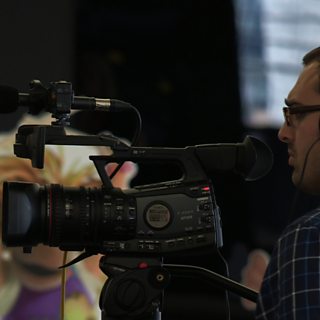
In previous posts from the Commonwealth Games in Glasgow we’ve looked at how ±«Óătv R&D is helping the corporation plan for the future of TV, . This is what you might call the heartland of what the ±«Óătv does - deliver the best TV it can to as many people as it can as cheaply as it can. However the audience experience is not fundamentally different to what we are all used to - you are still watching TV in your home or on the go, it’s just being delivered via more efficient methods and looks prettier.
In this post we’re going to take a look at some of the different audiovisual experiences that IP delivered UHD content makes possible that expand on the traditional TV viewing experience and provide truly new and innovative audience experiences. You can come and get hands on with all of these experiences .
Ultra-high definition pictures display at anything up to nearly 4000 pixels across (hence the 4K moniker), compared to standard HD at 1920. Because of this extra resolution the pictures can be used in fundamentally different ways to being displayed on a television set. Effectively your window onto the world is greater using UHD so there are opportunities to manipulate the image - zooming into it or panning around it - without losing visual clarity.
The Venue Explorer - redefining the Live experience
One project taking advantage of this characteristic of UHD pictures is the . Current broadcast coverage of live events provides an experience very different to being there in person. The views are controlled by cameramen and the director whereas if you were there yourself you would be able to look where you want.
At events like the athletics at the Commonwealth Games where there are often a number of track and field events on at the same time we would like to give viewers the ability to look around freely and focus on the events they are interested in. The Venue Explorer project allows this by using a UHD picture that retains resolution even when magnified significantly.
At the you can use the Venue Explorer project to view the live athletics at Hampden Park, using tablets to zoom into the action and watch the events that you want.
The Venue Explorer showing a zoomed in image of the UHD live stream
Augmented Video Player - the start of the journey
While UHD allows the manipulation of images without a loss of resolution, the fact that this content is delivered over IP also has an impact on what you can do with video images. The department is involved in experiments to see if it’s possible to overlay video images with other layers of information delivered via IP so that the experience of watching TV becomes the start of a journey rather than the end.
The uses additional layers of data to increase audience interaction and engagement. The idea is that eventually there will be multiple overlays available to viewers so that you could choose what kind of information you would like to be displayed. If you were watching Formula One for example you might like to switch between biometric data for the drivers and mechanical details of the cars depending on what was happening in the race. The video below shows the Augmented Video Player in action using gymnastics footage from the Commonwealth Games.
360-degree video - Virtual Reality’s back!
Virtual Reality headsets use a video screen and physical masks to block out external light and create a video image that takes up your entire field of view. Moving your head around allows you to see different areas of the environment just as if you were really there.
Typically most VR headsets use computer graphics to relay the action - you can use them to explore ancient Rome or ride on a roller coaster. For R&D’s prototype we have instead attempted to use live video so you can explore “real” environments. A 360-degree video camera situated in The Hydro Stadium is live streaming coverage to a VR headset at the Glasgow Science Centre. Using it you can drop in on the action at the Hydro without ever setting foot in the building.
The 360-degree camera at the Hydro stadium
Audio Innovation - making the pictures make sense
Sound carries a huge amount of the information that allows human beings to interpret what’s going on around them. You might think vision is more important but try watching a television programme with sound off and see how much information you come away with. ±«Óătv R&D has a large team dedicated to audio research & development. Over the years the department has been responsible for audio innovations such as Nicam and DAB.
The development of these new audiovisual experiences requires a new approach to how sound is captured, processed and presented to the listener. With 360-degree systems it is important that the sound matches the pictures - the audio through a VR headset needs to rotate as the user moves their head for example.
For the Venue Explorer project the audio needs to correspond to the part of the scene that you have chosen to look at, and provide the viewer with details relating to what they are seeing.
To that end most of the R&D projects at our Commonwealth Games showcase have had input from the Audio Research team and you can see details of their projects on their dedicated pages on the R&D website.
